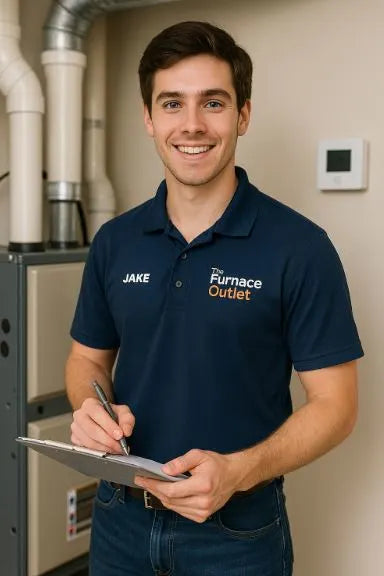Real-World Costs: How Much to Install a 40,000 BTU Furnace & AC System in 2025
When it comes to installing a 40,000 BTU furnace and air conditioning system in 2025, the costs can vary widely based on factors like the system’s efficiency, your location, and the complexity of the installation. Understanding the full scope of what you’ll be paying for can help you budget more effectively and avoid unexpected expenses.
Here’s a detailed breakdown of what you can expect in terms of equipment, labor, and other associated costs.
📊 Average Installation Costs in 2025
The total cost to install a 40,000 BTU furnace and AC system in 2025 will typically fall within a range depending on the system's efficiency, your home’s needs, and additional installation requirements. Here’s a rough cost guide:
-
Low-end (Standard Efficiency): $4,500–$6,000
-
Mid-range (Higher Efficiency, Minor Ductwork): $6,500–$8,500
-
High-end (Premium Efficiency, Full Duct Replacements): $9,000–$11,000+
These figures encompass equipment, labor, and basic installation materials. In most cases, you can expect additional costs for upgrades like ductwork or electrical changes.
(Source: The Furnace Outlet)
🛠️ Equipment Costs: Furnace, AC, and Accessories
The biggest chunk of your overall cost will come from the equipment itself. Here’s a breakdown of what you can expect to pay for both the furnace and air conditioner.
Furnace Costs
-
80% AFUE (Standard Efficiency): $900–$1,500
-
95–96% AFUE (High Efficiency): $1,200–$2,300
Air Conditioner Costs
-
13.4 SEER2 (Standard Efficiency): $1,400–$2,500
-
15–17 SEER2 (High Efficiency): $1,800–$3,200
Additional Accessories
-
Smart Thermostat: $80–$300
-
Line Sets, Pads, and Minor Parts: $150–$500
These are the general ranges for standard systems. If you’re upgrading to higher-efficiency models or purchasing premium features, expect costs on the upper end of these ranges.
(Source: The Furnace Outlet)
👷 Labor Costs: What’s Included in Professional Installation
Labor is a significant part of the total cost. Depending on your region and the complexity of the install, the typical labor rates will range between $75–$150 per hour.
What Labor Includes
-
Removing the old system
-
Installing new furnace and AC units
-
Connecting ductwork, refrigerant lines, and electrical wiring
-
Testing, calibrating, and ensuring system performance
A full installation usually takes 1–3 days. Professional installation includes both system setup and testing, so everything works as it should.
Average labor cost: $2,000–$5,000
(Source: The Furnace Outlet)
💡 Hidden Costs to Watch For
While the equipment and labor costs are the most obvious expenses, there are often hidden costs that homeowners miss. Make sure you factor these into your budget:
-
Electrical Upgrades: If your electrical panel can’t support the new system, you may need a panel upgrade, which can cost $500–$2,500.
-
Ductwork Repairs/Replacement: If your ducts need repair or full replacement, that will add another $1,500–$4,500.
-
Permit Fees: Depending on your location, you might need a permit, which could cost between $50–$500.
-
Disposal Fees: Don’t forget that old unit removal can add $100–$300 to the overall cost.
(Source: The Furnace Outlet)
✅ Budgeting Tips for a Smooth Install
Proper planning is essential to avoid overspending on your furnace and AC installation. Here are a few tips to help you stay within budget:
1. Get Multiple Quotes
Getting at least three quotes from licensed contractors helps you compare pricing and services. Contractors may suggest different solutions, so it’s important to understand the reasons behind their recommendations.
2. Check for Rebates and Tax Credits
There are often federal, state, or utility rebates available for high-efficiency systems. Make sure to check programs like Energy Star for any discounts or incentives.
👉 Energy Star HVAC Resources
3. Schedule During Off-Peak Times
The demand for HVAC systems usually peaks during summer and winter. If you can schedule your install during the spring or fall, you might get a lower price due to decreased demand.
4. Plan for Efficiency, Not Just Price
While high-efficiency systems can cost more upfront, they will save you money in the long run. High SEER and AFUE ratings result in lower energy bills, so it’s worth considering higher efficiency even if it costs more initially.
📈 Additional Resources for Cost Planning
There are plenty of tools and resources available to help you plan the cost of your furnace and AC installation. Here are some great resources to get you started:
-
HVAC Cost Calculator: Provides cost estimates based on your home’s size and the equipment chosen.
-
DSIRE State Incentive Search: A database of state and local incentives for energy-efficient HVAC upgrades.
-
Energy Star – Rebates and Incentives: Check for rebates on energy-efficient heating and cooling equipment.
These tools will help you get more specific cost breakdowns based on your location and needs.
🧰 DIY vs. Professional Installation: What You Can Do
While many people wonder if they can install the system themselves, certain parts of the job should always be left to professionals. However, there are tasks that homeowners can handle to save money, such as:
-
Ductwork cleaning and sealing
-
Installing a smart thermostat
-
Preparing the installation space (moving furniture, ensuring there’s adequate clearance for the units)
For anything involving electrical, gas lines, or refrigerant connections, professional installation is mandatory. Hiring a licensed HVAC technician ensures your system is installed safely, meets local building codes, and won’t void the manufacturer’s warranty.
📊 Final Takeaway: Planning Ahead Can Save You Money
Installing a 40,000 BTU furnace and AC system in 2025 is a significant investment. However, with the right approach, you can manage costs effectively. By considering equipment choices, labor costs, and potential hidden fees, you can create a realistic budget that doesn’t break the bank.
Don’t forget to check for rebates, choose energy-efficient options, and consult with licensed contractors to ensure you’re getting the best value for your home.
In the next Blog we will learn more about Maintenance Tips to Keep Your 40,000 BTU System Running Like New







